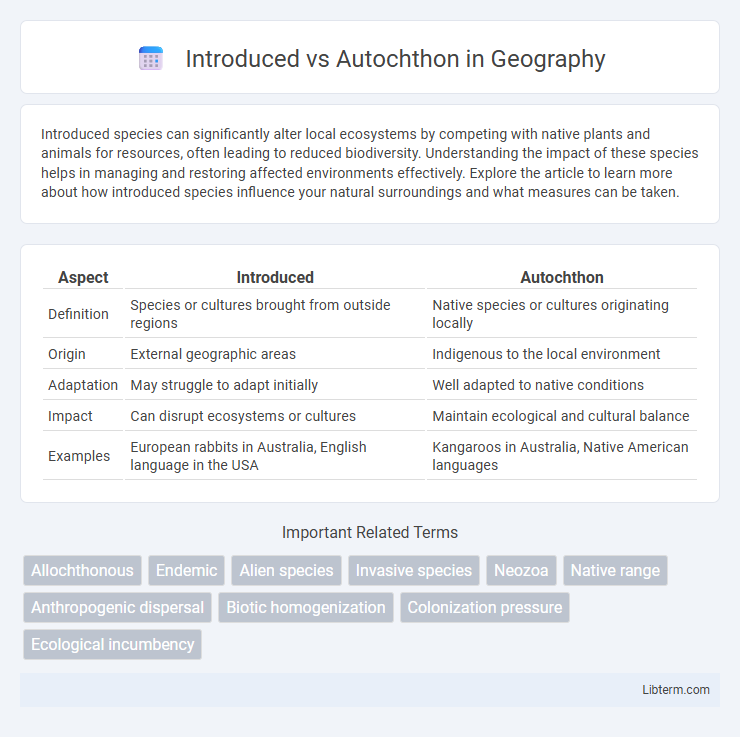Introduced species can significantly alter local ecosystems by competing with native plants and animals for resources, often leading to reduced biodiversity. Understanding the impact of these species helps in managing and restoring affected environments effectively. Explore the article to learn more about how introduced species influence your natural surroundings and what measures can be taken.
Table of Comparison
| Aspect | Introduced | Autochthon |
|---|---|---|
| Definition | Species or cultures brought from outside regions | Native species or cultures originating locally |
| Origin | External geographic areas | Indigenous to the local environment |
| Adaptation | May struggle to adapt initially | Well adapted to native conditions |
| Impact | Can disrupt ecosystems or cultures | Maintain ecological and cultural balance |
| Examples | European rabbits in Australia, English language in the USA | Kangaroos in Australia, Native American languages |
Definition of Introduced and Autochthon Species
Introduced species are organisms transported by human activities to new regions outside their native range, often disrupting local ecosystems. Autochthon species, also known as native or indigenous species, naturally occur in a specific geographic area without human intervention. Understanding the distinction aids ecological management by identifying species that evolved locally versus those introduced by anthropogenic actions.
Key Differences Between Introduced and Autochthon
Introduced species are organisms transported by human activity to areas outside their native range, often causing ecological disruption, whereas autochthonous species originate and evolve naturally within a specific ecosystem. Key differences include their adaptation processes, with autochthonous species co-evolving in local habitats, while introduced species may lack natural predators, leading to invasive behaviors. Management practices differ significantly, prioritizing conservation of autochthonous biodiversity and control or eradication of introduced populations to maintain ecological balance.
Historical Context of Species Introduction
Introduced species, often brought by humans either intentionally or accidentally, have altered ecosystems since ancient trade routes facilitated the movement of flora and fauna beyond their native ranges. Autochthonous species, in contrast, evolved naturally within their specific habitats over millennia, maintaining ecological balance and co-adaptations. Historical records reveal shifts in biodiversity patterns linked to colonial expansion and globalization, emphasizing the impact of introduced species on native ecological communities.
Ecological Impacts of Introduced Species
Introduced species often disrupt native ecosystems by outcompeting autochthonous species for resources, leading to reduced biodiversity and altered habitat structures. These invasive organisms can introduce new diseases, change nutrient cycling, and interfere with native species' reproductive processes, exacerbating ecological imbalance. Long-term ecological impacts include the decline or extinction of indigenous species and the transformation of ecosystem functions, which can compromise ecosystem resilience and services.
Benefits of Autochthon Species to Ecosystems
Autochthonous species, native to their ecosystems, support biodiversity by maintaining balanced food webs and providing habitats tailored to local conditions. Their adaptation to specific environmental factors enhances ecosystem resilience against disturbances like climate change and invasive species. These species improve soil health, promote nutrient cycling, and stabilize ecosystems more effectively than introduced species, which can disrupt native biotic communities.
Human Activities Leading to Species Introduction
Human activities such as global trade, transportation, and agriculture have significantly accelerated the introduction of non-native species into new ecosystems, often disrupting native biodiversity. Introduced species, also known as alien or exotic species, are transported intentionally or accidentally by humans, contrasting with autochthonous species that naturally occur in a region without human intervention. The deliberate release of horticultural plants, aquaculture, and pet trades are major pathways contributing to the establishment of introduced species in diverse habitats.
Case Studies: Successful and Harmful Introductions
Case studies reveal that introduced species like the European starling in North America have thrived, often outcompeting autochthonous species and disrupting local ecosystems. In contrast, successful introductions such as the biological control of the prickly pear cactus with the Cactoblastis moth in Australia highlight positive ecological management. Harmful introductions, exemplified by the Burmese python in the Florida Everglades, demonstrate severe impacts on autochthonous wildlife and biodiversity loss.
Strategies for Managing Introduced Species
Effective strategies for managing introduced species include early detection and rapid response to prevent establishment and spread. Habitat restoration and the promotion of native species resilience play a critical role in controlling invasive populations and reducing ecological impact. Integrated pest management techniques, combining biological, chemical, and mechanical controls, optimize outcomes while minimizing harm to autochthonous ecosystems.
Conservation Challenges for Autochthon Species
Autochthon species face significant conservation challenges due to habitat loss, invasive introduced species, and climate change altering their native ecosystems. Introduced species often compete for resources, predate on native populations, and disrupt ecological balances essential for autochthon species' survival. Effective conservation strategies must prioritize habitat restoration, invasive species control, and protection of genetic diversity to sustain autochthon species populations.
Future Trends in Biodiversity and Species Movement
Future trends in biodiversity highlight a growing impact of introduced species on native autochthonous populations due to climate change and increased global connectivity. Predictive models suggest accelerated species movement will disrupt established ecosystems, leading to novel hybrid zones and altered community dynamics. Conservation strategies must integrate advanced monitoring and adaptive management to mitigate the ecological consequences of these biogeographical shifts.
Introduced Infographic

 libterm.com
libterm.com